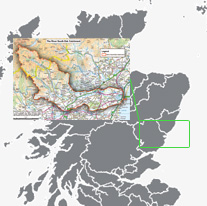Agriculture
Diffuse agricultural pollution arises from activities such as livestock grazing causing the riverbanks to wear away, ploughing and drainage being carried out too close to the river, fertiliser and pesticides used to grow crops, and from runoff from farms.
These activities can release potential pollutants such as sediments, nitrates and phosphates, which individually may not have an effect, but together, at the scale of a river catchment, can affect the quality of water. Much of this pollution is not deliberate and good agricultural practice can help tackle the problem.
However, we know that diffuse agricultural pollution is already an issue in the area. This is clear as the lower half of the catchment downstream of Finavon, was designated as a Nitrate Vulnerable Zone (NVZ) by the Scottish Executive in June 2002.
SEPA has also recorded poor and moderate ecological status results for the Pow, Melgund, and Lemno Burns and Montrose Basin.
The aim of NVZs is largely to tackle contamination of groundwater from agricultural sources. NVZs were designated in areas where groundwater (water stored in permeable rocks below the surface, known as aquifers) has concentrations of nitrates over a certain level (> 50 mg/litre nitrate). This also coincides with the main land use in these areas – agriculture.



